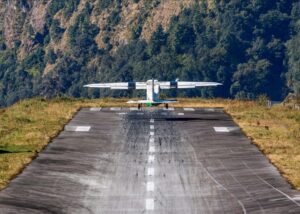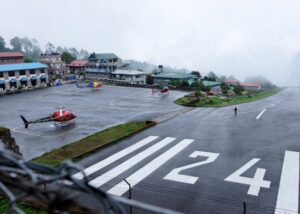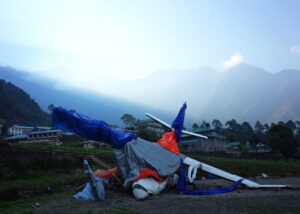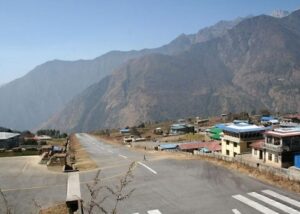Karan Bhatta from Simple Flying – Reports
With Sir Edmund Hillary having to buy land to construct an airport in Nepal and an accident-ridden history, Lukla Airport is one of a kind.
Summary
- Lukla Airport took close to a decade to construct, initiated by Sir Edmund Hillary in 1963 and completed in 1974.
- The airport is dangerous due to factors such as high elevation, short runway, surrounding mountains, and thin air.
- Lukla Airport’s closest substitute is Phaplu Airport, but it takes a few days of a hike to get to Lukla from there.
John Krakauer’s words, “Everest has always been a magnet for kooks, publicity seekers, hopeless romantics and others with a shaky hold on reality,” encapsulate why thousands of mountaineers and trekkers alike are drawn to the tallest mountain in the world. In this pursuit, their initial journeys aren’t marked along the routes that Sir Edmund Hillary and Tenzing Norgay Sherpa took to Lukla. Instead, most travelers opt to fly to this village, which is home to an exceptionally thrilling airport – Lukla, aka The Tenzing Hillary Airport, often dubbed the most dangerous in the world.
It is said that the name Lukla means an abode of sorts for goats and sheep despite a paucity of such creatures in the region. Many pilots have a dream of flying an aircraft to the airport here, while many passengers are visibly nervous during the flights when turbulence cuts, and they are left to wonder if the airport (or the flight to it) is not simply dangerous but downright fatal. Let’s take a look at some interesting facts about this airport that is shrouded with awe, wonder, mystique, and fear.
1/ Construction of the Airport took close to a decade
- Airport Elevation: 9,500 ft (2,896 m)
When Sir Edmund scaled Everest, he trekked from Jiri to Lukla and then mountaineered his way to becoming a celebrity. The route from Jiri to Lukla is known as the ‘classic’ way to get to the tallest mountain in the world. But Sir Edmund took the initiative to carve out an airport in the Everest region so that travel to this region would be easier.
However, finding people who would give up a sizable chunk of flattened land for the construction of an airport was an almost impossible cause. The only viable option was where the airport is currently perched. It was Hillary who acquired the land from the locals for a sum of around $2,700.

Photo: Vadim Petrakov | Shutterstock
It was in 1964 that Hillary took the initiative of building an airport in Lukla to make travel to the Everest region easier. The airport was not operational until September 1971 when a plane touched down at this airport. The airstrip was concretized only in 2001 after it was deemed that soil resistance was solid enough to merit such a process. The construction of the airport cut down the roundabout figure of five days to get to this place by foot from Jiri.
2/ There are plenty of reasons why it is dangerous
Runway length: 1,792 ft (527 m); Width: 98 ft (30 m)
Factors Affecting Aircraft Operations in Lukla
- Developments of pockets of cloud
- Surrounding mountain ranges
- Thin air
Possible Consequences
- Impossibility to navigate the aircraft
- Collision
- Not enough air resistance to halt the aircraft
An airport that stands at such an elevation as that of Lukla has two of the major parameters that affect its performance: air density and wind shear. In addition, one would also have to factor in variables such as temperatures, humidity, and the possibility of the development of pockets of clouds that will hamper its navigation, especially given the fact that you can only land with visual flying rules.

Photo: Vadim Petrakov | Shutterstock
3/ Lukla Airport has substitutes but can only accommodate small planes
Types of aircraft operating: Short Takeoff and Landing (STOL aircraft)
Airports close to Lukla Airport
- Syangboche Airport – Defunct
- Phaplu Airport – Operational
- Kangeldanda Airport – Defunct
Lukla Airport is known for its high altitude, short runway strip, and high gradient. These factors, taken together, can hazard a guess that only small planes will be able to land here. Small turboprops that can accommodate around 16 people such as De-Havilland DHC-6 Twin Otters, L-410 Turbolets, Pilatus PC-6 Porters, and Dornier Do-228s are the ones who take to the skies of Lukla.
Lukla is located in the Solukhumbu district of Nepal. This district, which also houses the Sagarmatha National Park, is home to 4 airports, only one of which is a viable alternative to the Lukla airport. This surrogate is known as Phaplu Airport. If one were to start a hike from Phaplu, it would take close to 4 days to get to Lukla. Even the Phaplu airport only accommodates 16-seater aircraft.
Synagboche Airport is located almost a two-day trek from Lukla Airport and around a two-hour walk from Namche Bazaar. According to The Nepal Times, here were widespread fears that if a fully functional airport operated in Syangboche, people wouldn’t take the flight to Lukla but opt to fly to Syangboche instead. With virtually no planes taking off from/to here these days, the airport has become a favorite spot where helicopters land to deliver bulky items needed for construction in the Khumbu region..
Kangeldanda is the fourth airport in Solukhumbu. It has a runway length of 520 meters and a width of 26 meters. Despite the country investing millions in the construction of the airport, it has turned into land for grazing and is among the more than 20 airports in Nepal that lie in a state of abandonment.
4/ Lukla’s accident-prone history gives passengers a chill
14th April 2019 (Let L-410UVP-E20, Summit Air)
- 2 – Number of fatalities
27th May 2017 (Let L-410UVP-E20, Summit Air)
- 2 – Number of fatalities
28th September 2012 (Dornier 228-202, Sita Air)
- 19 – Number of fatalities
8th October 2008 (DHC-6 Twin Otter 300, operated by Yeti Airlines)
- 18 – Number of fatalities
Nepal, as a country, has been barred from taking any of its airliners into European skies due to poor safety records. The Yeti Airlines Flight 691 crash last year only dampened whatever efforts the nation was making to convince the international community that it was bettering its efforts. Though there have been no major accidents in Lukla for quite a while, its history of fatal crashes reminds us why it is deemed to be dangerous.

Photo: art of line | Shutterstock
The first of the major accidents took place in Lukla around a decade after the airport opened. 2008 and 2012 marked the years when the airport saw two of its deadliest accidents, where 18 and 19 people were killed, respectively. Lukla is the focal point of booming helicopter tourism in the Everest region, but the crash of a chopper (in July) that had taken off from Lukla was a reminder of the challenges of flying in and around this airport.
5/ Most of the flights take place in the morning
Mountainous regions of Nepal have the most unpredictable weather. This is why if you are taking an afternoon flight on an STOL aircraft to Lukla (or other similar airports), the chances of cancellation are extremely high. Despite a strikingly clear morning, the most inclement weather can envelop the airport in no time. With limited options of a go-around and no Instrument Landing System(ILS), most of the flights in Lukla take place in the early morning up to noon.
Mornings aren’t a guarantee that the flights will take off to and from this airstrip. At certain times in the past, thousands of tourists have been stranded in Lukla, waiting for a flight for more than a week. When the Khumbu region is snow-leaden, Lukla Airport needs a sizable number of workers to do away with the snow to make way for flights.

Photo: Reinhard Kraasch via Wikimedia Commons
Get in touch
© Sentinel Aviation. Company No. 09400896. Vat No. 221163359.
All rights reserved. Created by AJA Design.
